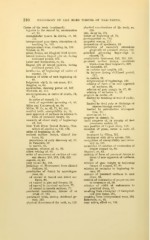Page 462 - My FlipBook
P. 462
310 PATHOLOGY OF THE HARD TISSUES OF THE- TEETH.
Caries of the teeth (continued). physical examinations of the teeth, re,
injuries to the enamel by, examination 120.
of, 83. pits, decay in, 124.
interglobular spaces in dentin, re, 69, points of beginning of, 75.
125. predisposition to, 115.
interproximal gum tissue, absorption of, pregnant women, 117.
resulting in, 103. preparation of specimens, 83.
interproximal wear, resulting in, 106. prevention of secondary extensions
Koeker, re, 62. gingivally of proximal decays, 102.
labial decays, see Gingival third decays. principle governing beginnings in
lateral incisors, lingual pits of, during enamel, 75.
childhood period, 272. prophylactic treatment, 143, 182, 188.
proximal surface decays, conditions
Leber and Rottenstein, re, 64.
lingual pits of lateral incisors, during which cause food lodgments, 102.
in bicuspids, 97.
childhood period, 272.
in incisors and cuspids, 107.
localization of beginnings of caries of
in incisors during childhood period,
enamel, 74.
272.
location of nidus of each beginning of,
in molars, 93.
89.
misplacement of beginnings, 100.
lodgments which do not cause, 111. relation of form of to near approach
Magitot, re, 64.
of surfaces, 86.
mastication, cleaning power of, 167.
relation of gum margin to, 87, 89.
Michaels, re, 129.
relation of occlusion to, 85.
microorganisms, in caries of dentin, 71,
progress in dentin, 69.
73.
limited by breaking of wall of cavity,
in caries of enamel, 74.
72.
limit of superficial spreading of, 89.
limited by dead pulp or discharge of
Miles and Underwood, re, 64.
abscess through canals, 72.
Miller, W. D., re, 65, 71, 91, 142. limited by putrefactive decomposi-
mottled teeth, susceptibility to, 40. tion, 72.
near approach of surfaces in relation to
slowness of, 72.
form of proximal decays, 86.
progress in enamel, 74.
necessity of closer study of beginnings rapid progress of, in atrophy of first
of, 143. permanent molars, 22.
New York State Dental Society, Com- rare position of lingual decay, 112.
mittee of, studies re, 131, 136. recession of gums, caries in cases of,
nidus of beginning of, 89. 230.
occlusal surface decays, clinical fea- treatment by filling, 231.
tures, 92. treatment with silver nitrate, 231.
importance of early discovery of, 97. recognition of susceptibility and immu-
in bicuspids, 97. nity to, 137.
in molars, 92. recurrence of, relation of restoration of
occlusion, relation of, to, 85. proper contact to, 90.
oldest writing of, 60. Regnard, re, 63.
order of occurrence of cavities of vari- relation of form of proximal decays to
ous classes, 203, 208, 216, 225. areas of near approach of surfaces,
osmosis, re, 68. 86.
pain caused by, 144. relation of gum margin to beginning
pathology of, divorcement from clinical decays of enamel, 87, 89.
features, 91. relation of occlusion to beginning de-
penetration of dentin by microorgan- cays, 85.
isms, 69. relation of proximal surfaces to each
of enamel in buccal and labial sur- other, 86.
faces, 90. relation of restoration of proper contact
of enamel in pits and fissures, 76. to recurrence of, 90.
of enamel in proximal surfaces, 77. relation of width of embrasures to
of enamel in smooth surfaces, 77. proximal decay, 87.
peridental membrance, disease of as resulting from absorption of interproxi-
result of, 103. mal gum tissue, 103.
permanent teeth, during childhood pe- resulting from interproximal wear, 104.
riod, 265. Robertson, re, 62.
physical characters of the teeth, re, 118. ropy saliva, effect on, 136.


